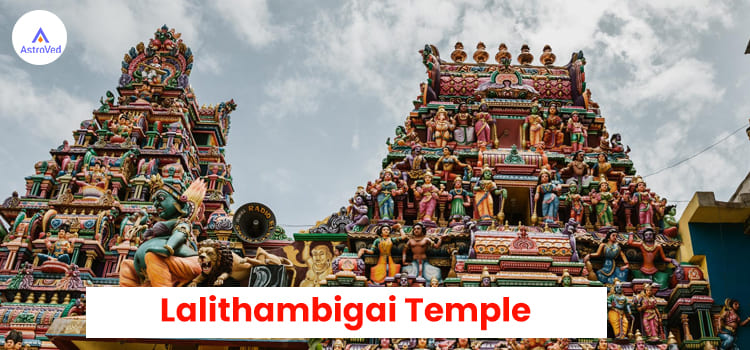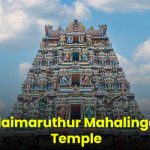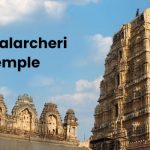The famous Temple of Goddess Lalithambigai is situated in the Tirumeeyachur village in the Tiruvarur district of Tamil Nadu. This is actually a Shiva Temple, whose presiding deity is worshiped as Meganatha Swamy, and his consort is Goddess Lalithambigai, but it has become more famous as the Lalithambigai Temple. This ancient Temple lies on the southern bank of the river Kaveri and has been praised by the Nayanmaars in their Thevaram hymns.
Tirumeeyachur Temple Legend
Once, a much-feared demon, Pandasura, began harassing the celestials and the sages. Unable to bear his atrocities, they surrendered to Goddess Adi Parashakti for relief. The Divine Mother assured them of protection and rose from the fires of the Yaga Kunda as Lalithambiga mounted the chariot Sri Chakra Ratha and took on the mighty demon. In the fierce war that ensured, the Goddess overpowered the Asura and slew him, relieving the universe of his cruelties. However, her fury continued unabated. Realizing the gravity of the situation, Shiva intervened and sent Shakti to pacify Lalithambiga. Accordingly, Shakti came down as Manonmani and soothed and calmed down Lalithambiga. The serene Goddess then reached this place, created the Vag Devis, the deities to rule the spoken words, and asked them to chant her 1000 names. Thus was born the powerful hymn Lalitha Sahasranamam, the 1000-Sacred names of Goddess Lalithambiga, at this Sacred Temple of Thirumeeyachur.
Mythology also holds Thirumeeyachur as the place of birth of Shaneeswara, the mighty planetary lord; Yama, the feared God of Death; Aruna, the charioteer of the Sun; and the famous Ramayana characters Vali and Sugreeva.
Tirumeeyachur Lalithambigai Temple History and Structure
There are differing opinions about this Temple’s historical background. Inscriptions and some records consider this Temple more than 1000 years old. People believe that this Temple of the Dravidian architectural style was originally a brick structure built by King Kochengat Cholan. Subsequently, during the reign of the great King Rajaraja, Sembiyan Mahadevi, a royal of the Chola dynasty, made it into a stone structure, as we see it in the present times. The Pandyas made additions later and further expanded the Temple.
Call it fact or fiction, this Temple is said to have been erected by a king at Divine command. It is also believed that many powerful kings from all parts of the land visited this place to seek Shiva’s grace and made generous donations of all kinds to the deities here. These donations, in the form of precious items and jewelry, still remain hidden in the Temple as invaluable treasures.
This east-facing Temple has a 5-tier Rajagopuram, followed by the Balipeedam (the altar for making offerings like rice and water), Dwajasthambam (the flag mast), and Rishabam (Shiva’s bull mount). Another 3-tier tower inside leads us further into the Temple.
Shiva, as Meganatha Swamy, is the principal deity of the Temple, and he is in the Lingam form, whom devotees can worship in the sanctum. The superstructure of this main shrine is called the Gajaprushta Vimana, a tower designed as the back of an elephant.
His consort is Goddess Lalithambigai, who is housed in a separate shrine that falls to the right as one enters through the main tower. She is in Sukhasana, a comfortable sitting posture adorned with anklets. Thirumeeyachur is regarded as the first Shakti Peetam, the seat of Divine Feminine Energy; hence, this Ambal (Goddess) is hailed as Adi Parashakti, the Primordial Supreme Feminine Power.
The Temple also has shrines for Brahma, Vishnu, Dakshinamurthy, Vinayaka, Durga, Naalvar (the 4 Naayanmars, the ardent Shiva devotees) and many other divinities. A 4-faced Chandikeswara can be called a specialty of this Temple.
Religious Significance of the Thirumeeyachur Lalithambigai Temple
Though it is principally a Shiva Temple whose presiding deity is Meganatha Swamy, this Thirumeeyachur Temple is more famous as Lalithambikai Temple after the Goddess, which people identify as the Sacred location of origin of the highly efficacious Lalitha Sahasranamam hymn.
Many devotees come to this Temple not only for worship but also for performing rituals.
According to belief, Yama, the God of Death, who was born here, performed Abishekam to Shiva with 1008 conches, which have the Divine power to grant longevity. Hence, people come here to witness the Abishekam and also perform Mruthyunja Homa and Ayush Homa for relief from illnesses and for a long and healthy life. They also offer cooked rice mixed with Pirandai (Veldt Grape) to the deity on a lotus leaf and consume it later as Prasad for curing diseases. People also pray to the Divine couple here for early marriage after clearing obstacles and for progeny blessings by offering garlands and anklets to Lalithambigai.
Ratha Sapthami, which occurs during January-February, involves a grand celebration in the Temple. They also enthusiastically celebrate the Navaratri festival here, with special Poojas and worship on Vijayadasami, the 10th Day of Ultimate Victory.


